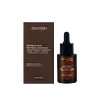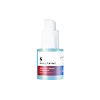What's inside
What's inside
 Key Ingredients
Key Ingredients

 Benefits
Benefits

 Concerns
Concerns

 Ingredients Side-by-side
Ingredients Side-by-side

Water
Skin ConditioningPropylene Glycol
HumectantGlycolic Acid
BufferingNiacinamide
SmoothingSalicylic Acid
MaskingButylene Glycol
HumectantAmylopectin
Xanthan Gum
EmulsifyingDextrin
AbsorbentChamomilla Recutita Flower Extract
MaskingAloe Barbadensis Leaf Juice
Skin ConditioningFucus Vesiculosus Extract
EmollientRubus Idaeus Fruit Extract
AstringentAcer Saccharum Extract
Skin ConditioningPortulaca Oleracea Extract
Skin ConditioningHydroxypropyl Bisstearamide Mea
Skin ConditioningPolyglutamic Acid
Skin ConditioningTetrasodium EDTA
Sodium Hydroxymethylglycinate
PreservativeTriethanolamine
BufferingDipropylene Glycol
HumectantBehenyl Alcohol
EmollientCeteareth-20
CleansingCholesteryl Isostearate
EmollientTricaprylin
MaskingCetearyl Alcohol
EmollientSqualane
EmollientCholesterol
EmollientStearic Acid
CleansingDimethicone
EmollientPhenoxyethanol
PreservativeWater, Propylene Glycol, Glycolic Acid, Niacinamide, Salicylic Acid, Butylene Glycol, Amylopectin, Xanthan Gum, Dextrin, Chamomilla Recutita Flower Extract, Aloe Barbadensis Leaf Juice, Fucus Vesiculosus Extract, Rubus Idaeus Fruit Extract, Acer Saccharum Extract, Portulaca Oleracea Extract, Hydroxypropyl Bisstearamide Mea, Polyglutamic Acid, Tetrasodium EDTA, Sodium Hydroxymethylglycinate, Triethanolamine, Dipropylene Glycol, Behenyl Alcohol, Ceteareth-20, Cholesteryl Isostearate, Tricaprylin, Cetearyl Alcohol, Squalane, Cholesterol, Stearic Acid, Dimethicone, Phenoxyethanol
Water
Skin ConditioningArtemisia Vulgaris Extract
Skin ConditioningAloe Barbadensis Leaf Extract
EmollientGlycolic Acid
BufferingCalendula Officinalis Flower Extract
MaskingMethyl Gluceth-10
EmulsifyingSodium Hydroxide
BufferingDipropylene Glycol
HumectantPentylene Glycol
Skin ConditioningBetaine
HumectantSalicylic Acid
Masking1,2-Hexanediol
Skin ConditioningAmylopectin
Dextrin
AbsorbentXanthan Gum
EmulsifyingSodium Hyaluronate
HumectantGlycerin
HumectantAllantoin
Skin ConditioningPanthenol
Skin ConditioningMelia Azadirachta Leaf Extract
Skin ConditioningEthylhexylglycerin
Skin ConditioningMelia Azadirachta Flower Extract
Skin ConditioningAmino Esters-1
Skin ConditioningPolyquaternium-51
Skin ConditioningTrisodium Ethylenediamine Disuccinate
Dipotassium Glycyrrhizate
HumectantCoccinia Indica Fruit Extract
Skin ConditioningButylene Glycol
HumectantSolanum Melongena Fruit Extract
Skin ConditioningAloe Barbadensis Flower Extract
EmollientOctanediol
Curcuma Longa Root Extract
MaskingOcimum Basilicum Flower/Leaf Extract
TonicPearl Powder
Lawsonia Inermis Flower/Fruit/Leaf Extract
MaskingOcimum Sanctum Leaf Extract
Skin ConditioningTocopherol
AntioxidantWater, Artemisia Vulgaris Extract, Aloe Barbadensis Leaf Extract, Glycolic Acid, Calendula Officinalis Flower Extract, Methyl Gluceth-10, Sodium Hydroxide, Dipropylene Glycol, Pentylene Glycol, Betaine, Salicylic Acid, 1,2-Hexanediol, Amylopectin, Dextrin, Xanthan Gum, Sodium Hyaluronate, Glycerin, Allantoin, Panthenol, Melia Azadirachta Leaf Extract, Ethylhexylglycerin, Melia Azadirachta Flower Extract, Amino Esters-1, Polyquaternium-51, Trisodium Ethylenediamine Disuccinate, Dipotassium Glycyrrhizate, Coccinia Indica Fruit Extract, Butylene Glycol, Solanum Melongena Fruit Extract, Aloe Barbadensis Flower Extract, Octanediol, Curcuma Longa Root Extract, Ocimum Basilicum Flower/Leaf Extract, Pearl Powder, Lawsonia Inermis Flower/Fruit/Leaf Extract, Ocimum Sanctum Leaf Extract, Tocopherol
Ingredients Explained
These ingredients are found in both products.
Ingredients higher up in an ingredient list are typically present in a larger amount.
We don't have a description for Amylopectin yet.
Butylene Glycol (or BG) is used within cosmetic products for a few different reasons:
Overall, Butylene Glycol is a safe and well-rounded ingredient that works well with other ingredients.
Though this ingredient works well with most skin types, some people with sensitive skin may experience a reaction such as allergic rashes, closed comedones, or itchiness.
Learn more about Butylene GlycolDextrin is used to thicken a product and helps bind ingredients together. It is created from starch and glycogen.
As an emulsifier, dextrin prevents ingredients from separating. This helps elongate a product's shelf life.
Studies show coating UV filters with dextrin prevents these ingredients from being absorbed. This helps UV ingredients last longer on the skin.
Learn more about DextrinDipropylene Glycol is a synthetically created humectant, stabilizer, and solvent.
This ingredient helps:
Dipropylene glycol is technically an alcohol, but it belongs to the glycol family (often considered part of the ‘good’ alcohols). This means it is hydrating and gentle on skin unlike drying solvent alcohols like denatured alcohol.
As a masking agent, Dipropylene Glycol can be used to cover the smell of other ingredients. However, it does not have a scent.
Studies show Dipropylene Glycol is considered safe to use in skincare.
Learn more about Dipropylene GlycolGlycolic Acid is arguably the most famous alpha hydroxy acid (AHA) with tons of research backing its benefits.
It is found naturally in sugar cane but the form used in skincare is usually synthetic for purity and stability.
Glycolic acid removes the top layer of dead skin cells to allow newer and fresher ones to emerge.
AHAs work by breaking down the structural “glue” that holds old skin cells in place. When that buildup is gone, your skin can renew itself more efficiently.
Research also shows glycolic acid stimulates collagen production, helping to firm and thicken the skin over time. This is one of its biggest advantages over other AHAs.
Overall, glycolic acid helps with:
Fun fact: Glycolic acid boosts skin hydration by helping it produce molecules that increase hyaluronic acid naturally.
To work best, glycolic acid products should have a pH between 3-4 (that’s where exfoliation is most effective but still gentle on skin).
The pH and concentration of a product are key to its effectiveness:
It is normal to feel a slight stinging sensation when using glycolic acid. This usually fades as your skin adjusts.
Because glycolic acid has the smallest molecular size in the AHA family, it can penetrate deeper, which enhances its effectiveness but also makes it more likely to irritate sensitive skin.
If your skin is very sensitive or prone to rosacea, glycolic acid may be too strong; in that case, try milder options like lactic acid or a PHA instead.
Recent studies suggest glycolic acid might even help protect against UV damage. But don’t skip sunscreen! Freshly exfoliated skin is more sensitive to the sun.
Glycolic acid is a skincare superstar. It smooths, brightens, hydrates, and firms the skin. Unless you’re highly sensitive, it’s well worth adding to your routine.
Read more about some other popular AHA's here:
Learn more about Glycolic AcidSalicylic Acid (also known as beta hydroxy acid or BHA) is a well-known ingredient for treating skin that struggles with acne and clogged pores. It exfoliates both the skin's surface and deep within the pores to help clear out buildup, control oil, and reduce inflammation.
Unlike AHAs (alpha hydroxy acids), salicylic acid is oil-soluble. This allows it to penetrate into pores which makes it especially effective for treating blackheads and preventing future breakouts.
Salicylic acid is also known for its soothing properties. It has a similar structure to aspirin and can calm inflamed or irritated skin, making it a good option for acne-prone skin that is also sensitive.
Concentrations of 0.5-2% are recognized by the U.S. FDA as an over-the-counter topical acne product.
It can cause irritation and/or dryness if one's skin already has a compromised moisture barrier, so it's best to focus on repairing that before introducing this ingredient into your routine.
While salicylic acid does not increase sun sensitivity, it’s still important to wear sunscreen daily to protect your skin.
If you are looking for the ingredient called BHA or Butylated Hydroxyanisole, click here.
Learn more about Salicylic AcidWater. It's the most common cosmetic ingredient of all. You'll usually see it at the top of ingredient lists, meaning that it makes up the largest part of the product.
So why is it so popular? Water most often acts as a solvent - this means that it helps dissolve other ingredients into the formulation.
You'll also recognize water as that liquid we all need to stay alive. If you see this, drink a glass of water. Stay hydrated!
Learn more about WaterXanthan gum is used as a stabilizer and thickener within cosmetic products. It helps give products a sticky, thick feeling - preventing them from being too runny.
On the technical side of things, xanthan gum is a polysaccharide - a combination consisting of multiple sugar molecules bonded together.
Xanthan gum is a pretty common and great ingredient. It is a natural, non-toxic, non-irritating ingredient that is also commonly used in food products.
Learn more about Xanthan Gum